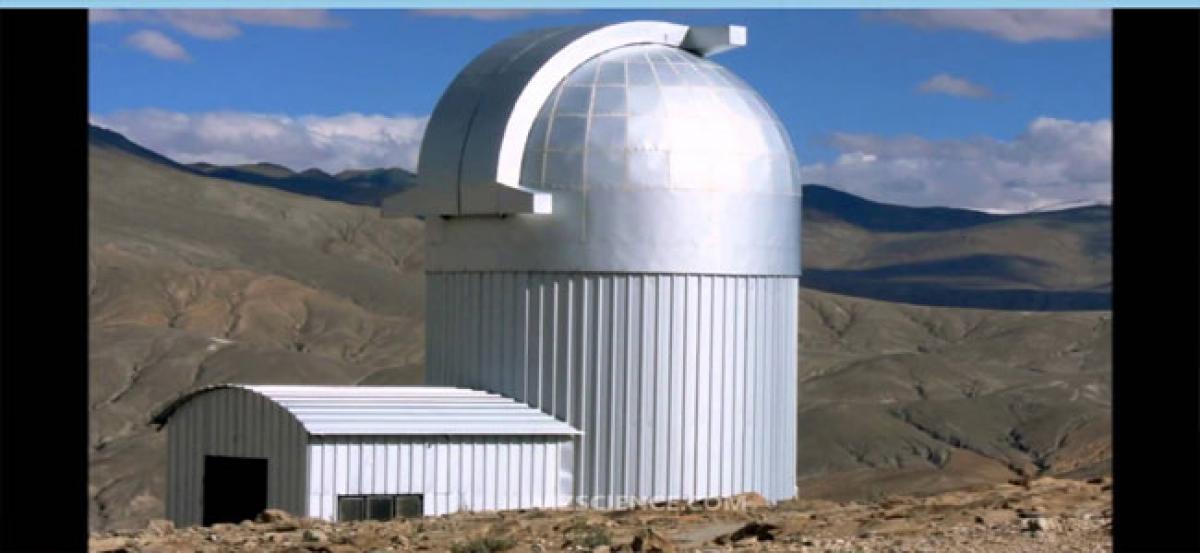Live
- Deputy CM Bhatti Vikramarka Inaugurates Power Substation, Criticizes BRS
- Major Phase in Old City Metro Land Acquisition, Cheques to Be Distributed
- Tragic Road Accident Near Medchal Checkpost: Family of Three Killed, Child Injured
- Road Accident on Hyderabad-Warangal National Highway: One Dead, Five Injured
- Massive Fire Breaks Out at Minerva Hotel in Hyderabad’s Himayatnagar
- PM Modi sets ball rolling for India to become world’s 2nd largest metro rail network
- Sexual assault case: Anna University asks students to use only bicycles inside campus
- Lack of genuine political leadership led to Manipur violence: Apex Meitei body
- Stage 3 restrictions under GRAP lifted in Delhi-NCR as AQI shows improvement
- No room for unmarried couples: Oyo explains check-in policy for partner hotels
Just In

Stars and galaxies in theuniverse may appear to be static to us as they are located millions oflight years away. But the universe is actually dynamic with eventsoccurring in timescales much shorter – years, days and even hours.India is now joining a global network to monitor the dynamic cosmos.
Hyderabad: Stars and galaxies in theuniverse may appear to be static to us as they are located millions oflight years away. But the universe is actually dynamic with eventsoccurring in timescales much shorter – years, days and even hours.India is now joining a global network to monitor the dynamic cosmos.
A new telescope is getting ready for commissioning at the Indian Astronomical Observatory at Hanle in Ladakh, as part of an international network specifically designed to watch dynamic events ortransient objects in the universe. The programme is called Global Relay of Observatories Watching Transients Happen (GROWTH).
Observatories in this network are located in a way that will allow uninterrupted observation of transient events. “A lot of interesting objects and events occur in the universe whichneed to be caught very young and soon after they happen, such as supernovae, gamma ray bursts, active galacticnuclei, and many more.
They are called transients becauseelectromagnetic signature radiated as a result is transient in nature.Gravitational wave events too fall in this category,” explained G CAnupama, the Indian principal investigator of the project at the Indian Instituteof Astrophysics, while speaking to India Science Wire here.
The facility will also track asteroids. “Near-earth asteroids arenot transients in the sense of their light emitting capability, butthey do come close to the earth and that is when you need totrack them. This time period is very short. In this sense, they are transient in terms of time,” said Anupama.
The new 70 cm telescope is much smaller than the 2 meter HimalayanChandra Telescope at Hanle. “HCT is already over-booked, whilethe new telescope will be purely for observing transients. It is different from HCT in the sense that it will only be an imaging telescope and all spectroscopy will happen at HCT,” Anupama said.
The fully robotic telescope costing Rs. 3.5 crore has been funded by the Science and Engineering Research Board (SERB) of the Department ofScience and Technology. “The telescope is equipped with a sensitivecamera that can detect some of the faint transients found by ourpartner survey telescopes like the Zwicky Transient Facility at Palomar, California,” she added. The new facility will becommissioned this summer.
The telescope will be remotely operated from IIA’s Centre ForResearch and Education in Science and Technology near Bangalore. Thefacility houses the control room for remote operations of the HCTand is the data hub for the telescope. The new telescope will be programmed to directly communicate with various ground-based andspace-based surveys that are searching for transient sources.
Transient events in the universe are caused due to several factorssuch as relatively benign flares on stars, accretion of matter oncompact objects, stellar mergers and explosions. All this results in aflash in the sky for a period and then slowly fades away. By capturing these electromagnetic signatures, astronomers try to gain an insight about cosmic objects as well as physical processes that govern theirevolution. Finding such objects requires continuous monitoring oflarge areas of the sky.
Telescopes deployed for ‘transientsurveys’ are usually small, wide-field instruments but they can’t see very faint objects. According to Dr. Mansi Kasliwal, who is heading GROWTH project atCaltech, the project is “primarily looking at optical transientsfrom a host of different observatories to build a more complete picture of the physical processes of their evolution. The network has18 observatories in the Northern Hemisphere. As the earth rotates and day light creeps, the network switches observations to facilities westward that is still enjoying night-time.”

© 2024 Hyderabad Media House Limited/The Hans India. All rights reserved. Powered by hocalwire.com







